Experimental and Numerical Investigations into the Effects of Rim Seal Structure on Endwall Film Cooling and Flow Field Characteristics
Abstract
:1. Introduction
2. Experimental Method
2.1. Experimental System and Test Section
2.2. Measurement Method of Film Cooling Effectiveness
3. Numerical Simulation Method
3.1. Numerical Settings
3.2. Turbulence Model Validation
3.3. Grid Independence Verification
4. Results and Discussion
4.1. Endwall Film Cooling Effectiveness
4.2. Flow Field Analysis
4.3. Aerodynamic Loss Analysis
5. Conclusions
- (1)
- The cooling effect of the PF was higher when the flow direction of the coolant and mainstream was opposite (both in the cases of AS and ASDS). When the MFR was greater than 1.0%, in the cases with a low MFR, the original structure (ORI) was more effective, and the adjustment to the seal structure had little effect on η on the endwall surface.
- (2)
- The case of DS changed the direction of flow out of the seal gap and the size of the two angular vortices at the outlet, resulting in the absorption of cold air energy and a decrease in η. Compared to the cases of ORI and DS, the cases of AS and ASDS had a smaller injection angle, which ultimately led to a higher η.
- (3)
- The aerodynamic loss became larger with the increment in the MFR, and the structural changes had little influence on the aerodynamic performance of the four seal structures. The aerodynamic performances of the DS, AS and ASDS cases were all better than that of the ORI case, and the cases of AS and ASDS could achieve a better cooling effect while having little impact on the aerodynamic penalty.
Author Contributions
Funding
Data Availability Statement
Conflicts of Interest
Abbreviations
| C | Concentration |
| Cax | Axial chord (mm) |
| H | Blade height (mm) |
| MFR | Mass flow ratio |
| P | Pressure |
| PF | Purge flow |
| RS | Rim seal |
| Re | Reynolds number |
| T | Temperature |
| Tu | Turbulence intensity |
| U | Velocity |
| h | Height |
| x | X axial length |
| Greek symbol | |
| α | Injection angle (°) |
| β | Blade geometric angle (°) |
| γ | Blade attack angle (°) |
| η | Film cooling effectiveness |
| ζ | Pressure loss coefficient |
| Subscripts | |
| aw | Adiabatic surface |
| c | Coolant |
| a | Area-averaged |
| loc | Local parameter |
| in | Inlet |
| out | Outlet |
| main | Mainstream |
| max | Maximum |
| mix | Mixture |
| l | Laterally averaged |
| t | Globally averaged |
| ref | Reference |
| s | Static |
| ∞ | Infinity of the passage |
References
- Beard, P.F.; Gao, F.; Chana, K.S.; Chew, J. Unsteady Flow Phenomena in Turbine Rim Seals. J. Eng. Gas Turbines Power 2017, 139, 032501. [Google Scholar] [CrossRef]
- Schädler, R.; Kalfas, A.I.; Abhari, R.S.; Schmid, G.; Voelker, S. Modulation and Radial Migration of Turbine Hub Cavity Modes by the Rim Seal Purge Flow. J. Turbomach. 2017, 139, 034416. [Google Scholar] [CrossRef]
- Blanco, E.D.L.R.; Hodson, H.P.; Vazquez, R. Effect of the Leakage Flows and the Upstream Platform Geometry on the Endwall Flows of a Turbine Cascade. J. Turbomach. 2009, 131, 011004. [Google Scholar] [CrossRef]
- Mclean, C.; Camci, C.; Glezer, B. Mainstream Aerodynamic Effects Due to Wheelspace Coolant Injection in a High-Pressure Turbine Stage: Part I—Aerodynamic Measurements in the Stationary Frame. J. Turbomach. 2001, 123, 401026. [Google Scholar] [CrossRef]
- Mclean, C.; Camci, C.; Engineering, O.A.; Glezer, B. Mainstream Aerodynamic Effects Due to Wheelspace Coolant Injection in a High-Pressure Turbine Stage: Part II—Aerodynamic Measurements in the Rotational Frame. J. Turbomach. 2001, 123, 687–696. [Google Scholar] [CrossRef]
- Kost, F.; Nicklas, M. Film-Cooled Turbine Endwall in a Transonic Flow Field. Part I—Aerodynamic Measurements. In Proceedings of the Asme Turbo Expo, New Orleans, LA, USA, 4–7 June 2001. [Google Scholar] [CrossRef]
- Reid, K.; Denton, J.; Pullan, G.; Curtis, E.; Longley, J. The Effect of Stator-Rotor Hub Sealing Flow on the Mainstream Aerodynamics of a Turbine. In Proceedings of the Asme Turbo Expo: Power for Land, Sea, & Air, Barcelona, Spain, 8–11 May 2006. [Google Scholar] [CrossRef]
- Gao, H.; Li, X.; Ren, J.; Jiang, H. Effect of leakage flow on the endwall cooling performance in high subsonic turbine cascade. Int. J. Therm. Sci. 2021, 170, 07140. [Google Scholar] [CrossRef]
- Lynch, S.P.; Thole, K. The Effect of Combustor-Turbine Interface Gap Leakage on the Endwall Heat Transfer for a Nozzle Guide Vane. J. Turbomach. 2008, 130, 812950. [Google Scholar] [CrossRef]
- Song, L.; Zhu, P.; Li, J.; Feng, Z. Effect of purge flow on endwall flow and heat transfer characteristics of a gas turbine blade. Appl. Therm. Eng. 2017, 110, 504–520. [Google Scholar] [CrossRef]
- Cong, Q.; Zhang, K.; Li, Z.; Li, J. Numerical Investigations on Gas Ingestion Mechanism Based on Flow Instabilities in Rim Seal and Cooling Characteristics of Endwall in a 1.5-Stage Axial Turbine. J. Eng. Gas Turbines Power 2023, 145, 055826. [Google Scholar] [CrossRef]
- Barigozzi, G.; Franchini, G.; Perdichizzi, A.; Maritano, M.; Abram, R. Purge flow and interface gap geometry influence on the aero-thermal performance of a rotor blade cascade. Int. J. Heat Fluid Flow 2013, 44, 563–575. [Google Scholar] [CrossRef]
- Mansouri, Z. Aerodynamic and heat transfer performances of a highly loaded transonic turbine rotor with upstream generic rim seal cavity. Propuls. Power Res. 2021, 10, 317–331. [Google Scholar] [CrossRef]
- Zhang, Z.; Zhang, Y.; Zhang, Y.; Dong, X.; Lu, X. Numerical investigation of the purge flow mechanisms and heat-transfer characteristics of turbine rim seals. Case Stud. Therm. Eng. 2022, 40, 02484. [Google Scholar] [CrossRef]
- Fiore, M.; Gourdain, N.; Boussuge, J.F.; Lippinois, E. Numerical Study of a Linear Cascade with Upstream Cavity Using Various Rim-Seal Geometries and Purge Rates. In Proceedings of the ASME Turbo Expo 2018: Turbomachinery Technical Conference and Exposition, Oslo, Norway, 11–15 June 2018. [Google Scholar] [CrossRef]
- Wang, X.; Liao, G.; Zhang, F.; Li, J. Numerical investigation on the steady and unsteady flow characteristics of rim seal for the first stage in gas turbine. Appl. Therm. Eng. 2016, 99, 11–22. [Google Scholar] [CrossRef]
- Schuler, P.; Kurz, W.; Dullenkopf, K.; Bauer, H.J. The Influence of Different Rim Seal Geometries on Hot-Gas Ingestion and Total Pressure Loss in a Low-Pressure Turbine. In Proceedings of the Asme Turbo Expo: Power for Land, Sea, & Air, Glasgow, UK, 14–18 June 2010. [Google Scholar] [CrossRef]
- Jia, X.; Zhang, H.; Jiang, Y. Performance of radial–axial clearance rim seal in realistic working conditions. Aerosp. Sci. Technol. 2018, 77, 373–387. [Google Scholar] [CrossRef]
- Jia, W.; Liu, H. Numerical investigation of the effect of rim seal on turbine aerodynamic design parameters and end wall flows in low-aspect ratio turbine. Comput. Fluids 2013, 74, 114–125. [Google Scholar] [CrossRef]
- Zhang, Z.; Zhang, Y.; Dong, X.; Qu, X.; Lu, X.; Zhang, Y. Flow mechanism between purge flow and mainstream in different turbine rim seal configurations. Chin. J. Aeronaut. 2020, 33, 2162–2175. [Google Scholar] [CrossRef]
- Wang, L.; Ma, H.; Zhang, J. Experimental Investigation of Effects of Rim Sealing Flow on the Flow Field in a Turbine Cascade Passage with Different Rim Seal Configurations. In Proceedings of the ASME Turbo Expo 2016: Turbomachinery Technical Conference and Exposition, Seoul, Republic of Korea, 13–17 June 2016. [Google Scholar] [CrossRef]
- Zhao, Q.; Yang, X.; Feng, Z. Effects of Rim Seal Geometries on Aerodynamic Performance and Rotor Platform Cooling in a One-Stage Turbine. In Proceedings of the ASME Turbo Expo 2020: Turbomachinery Technical Conference and Exposition, Virtual, 21–25 September 2020. [Google Scholar] [CrossRef]
- Zhang, Q.-C.; Tan, X.-M.; Wang, Q.-Q.; Zhang, J.-Z. Numerical investigation on effects of egress flow through different rim seals. Therm. Sci. Eng. Prog. 2023, 38, 01648. [Google Scholar] [CrossRef]
- Zhang, W.; Li, F.; Xie, Y.; Ding, Y.; Liu, Z.; Feng, Z. Experimental and numerical investigations of discrete film holes cooling performance on a blade endwall with mid-passage gap leakage. Int. J. Heat Mass Transf. 2023, 201, 23550. [Google Scholar] [CrossRef]



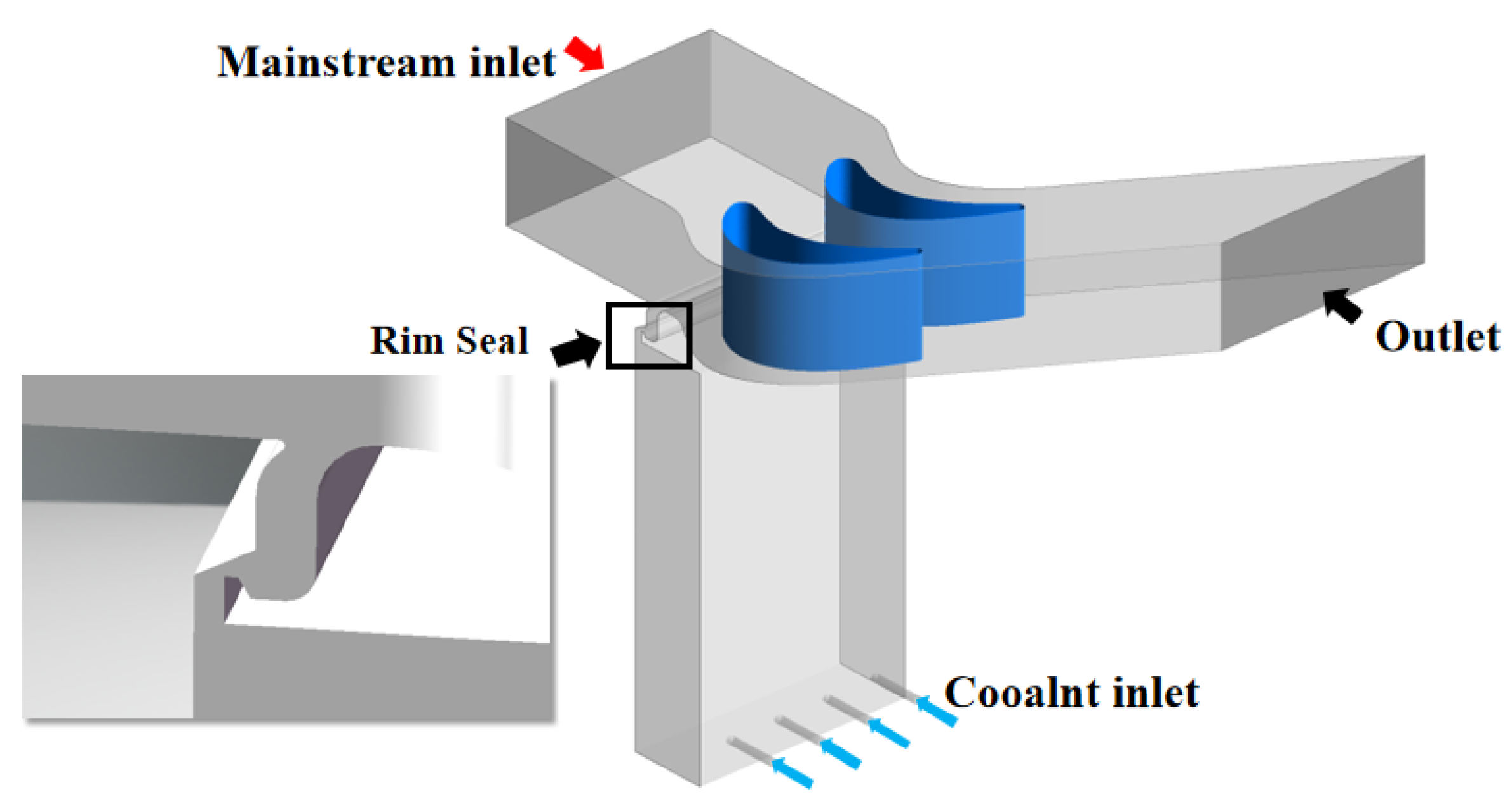


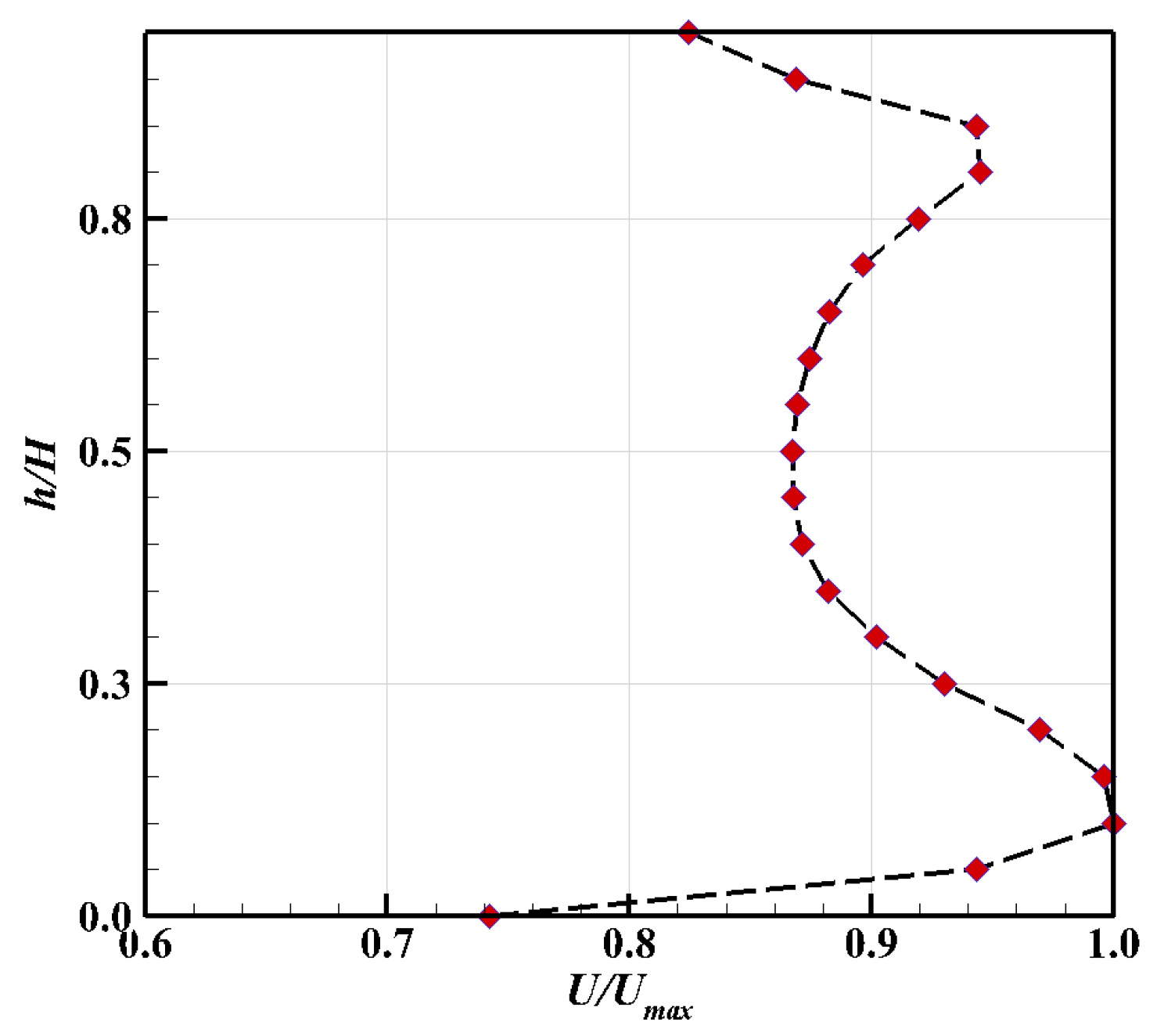
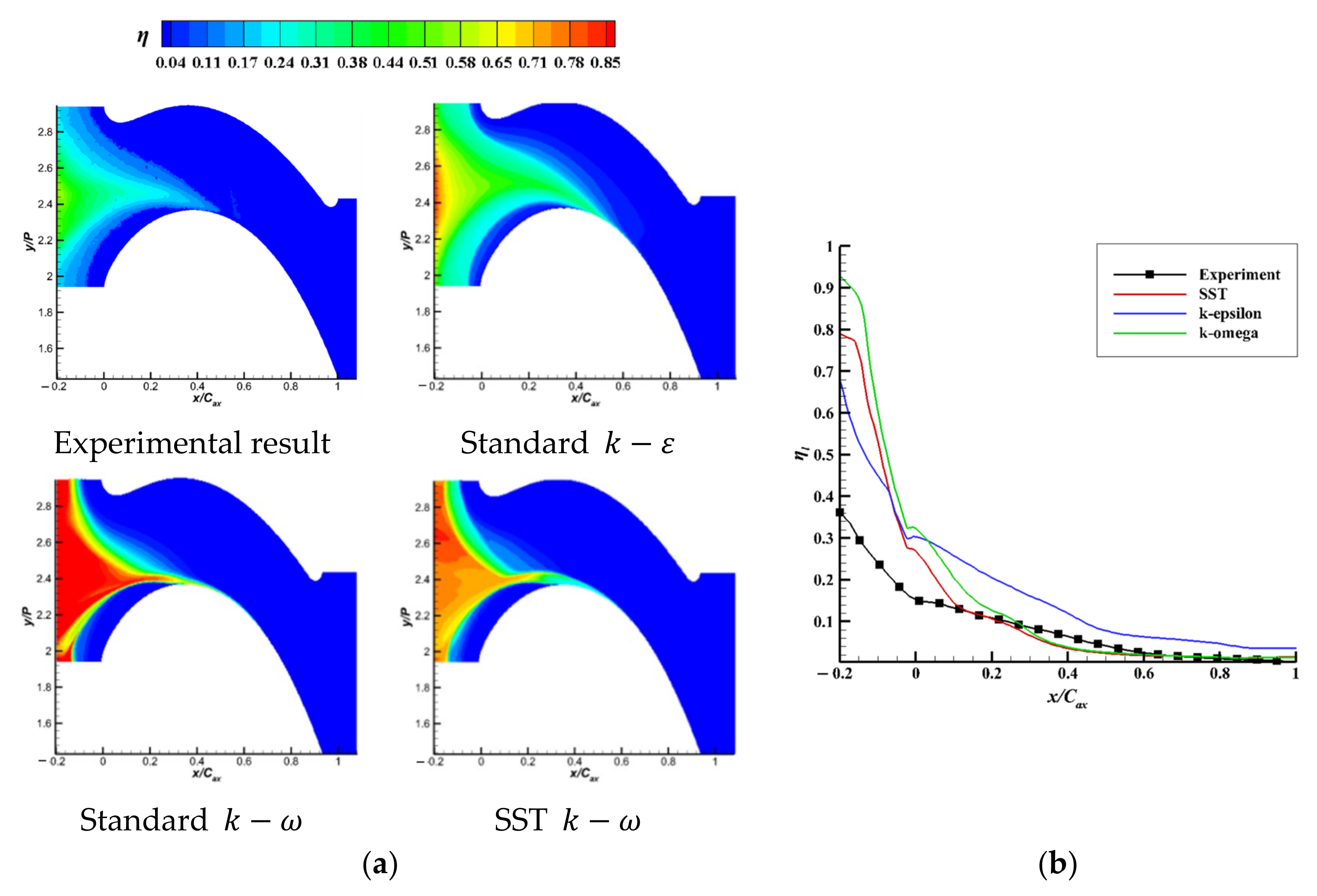
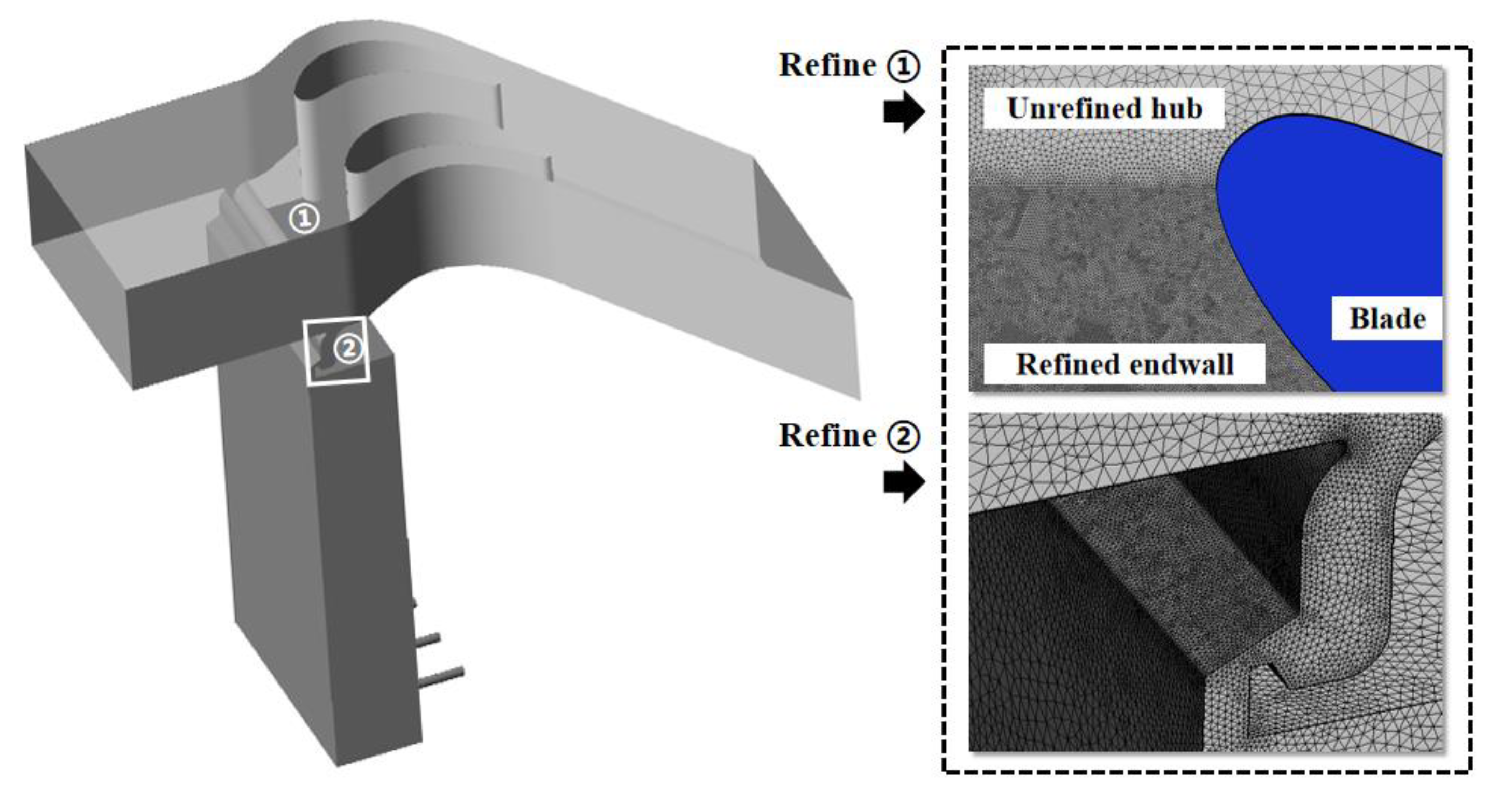

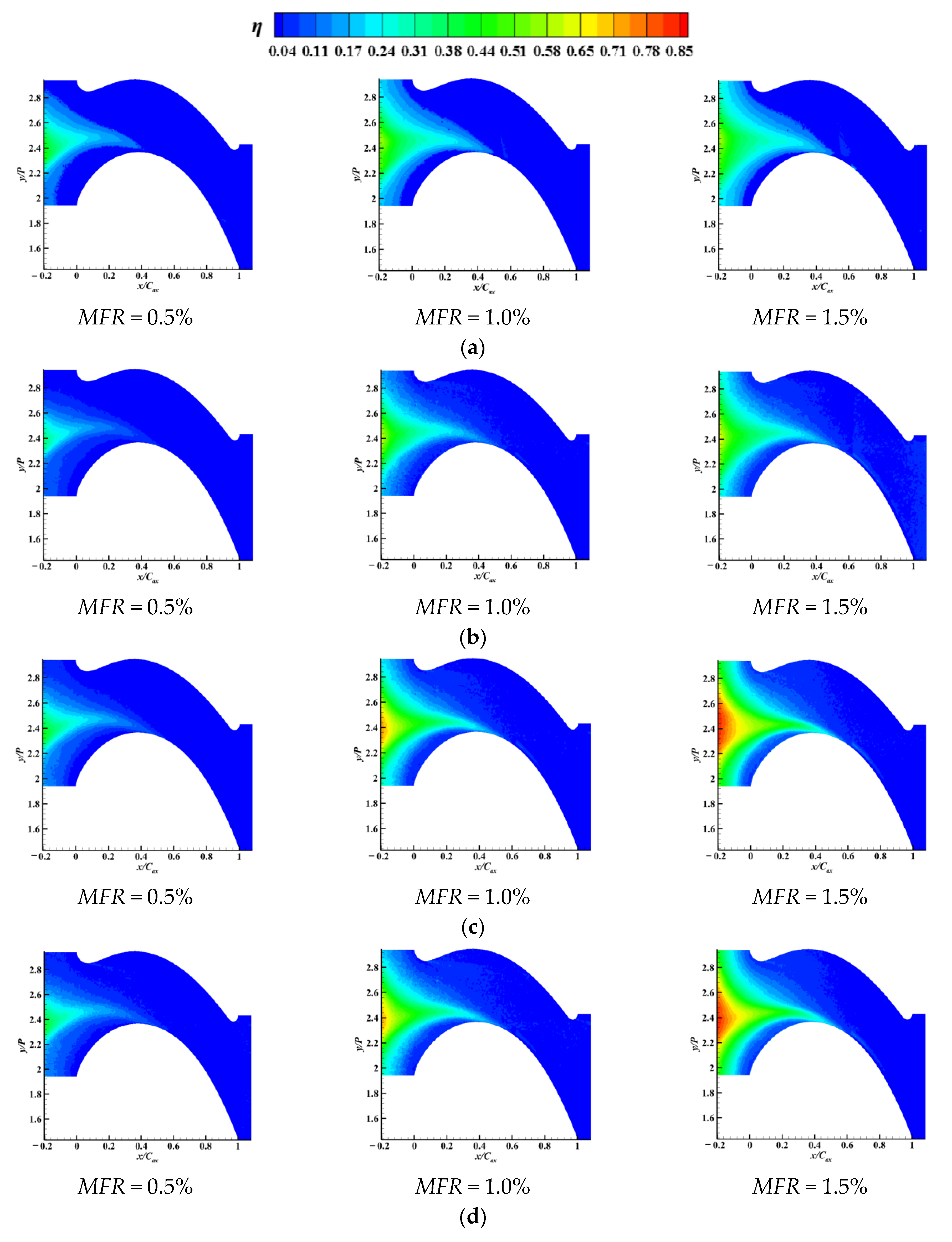
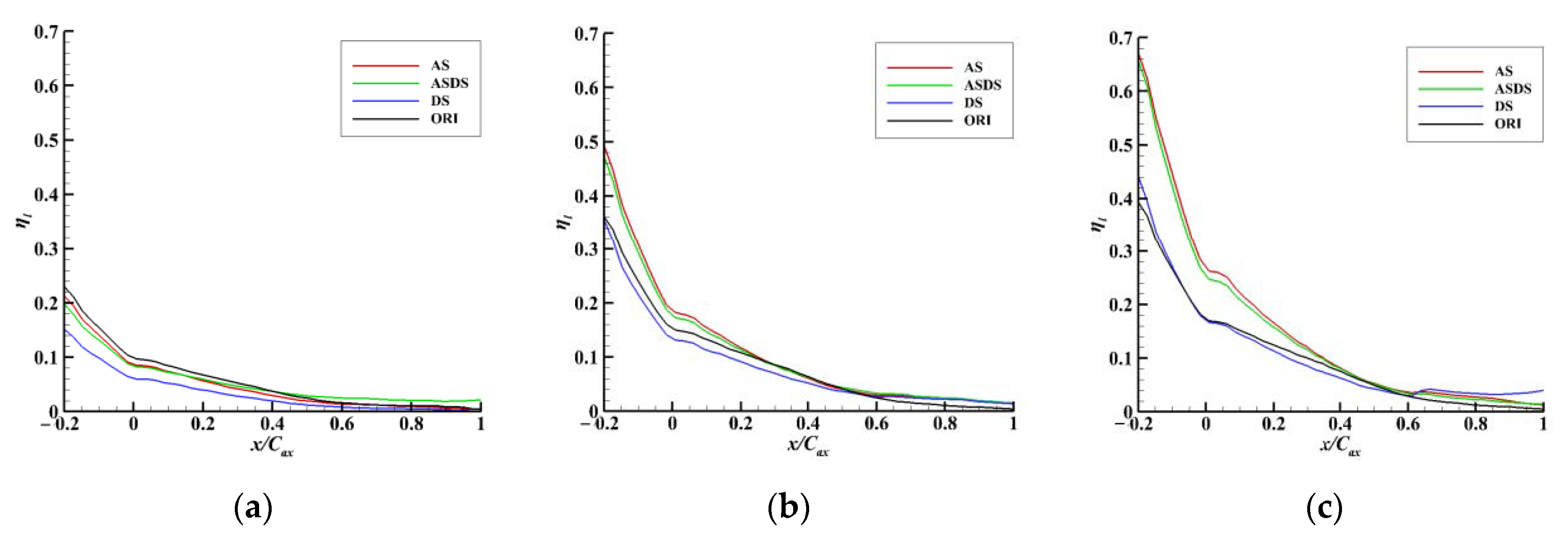

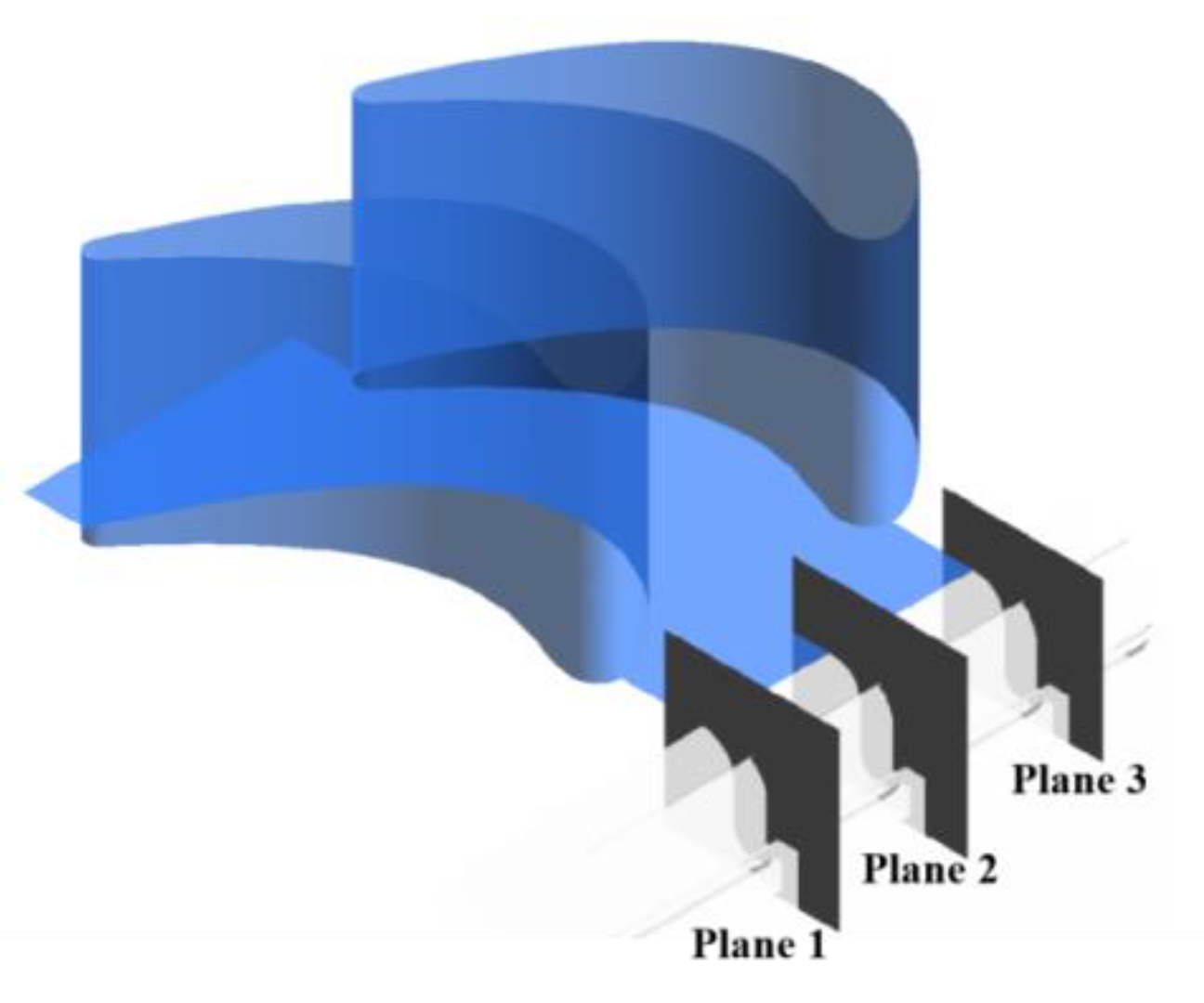




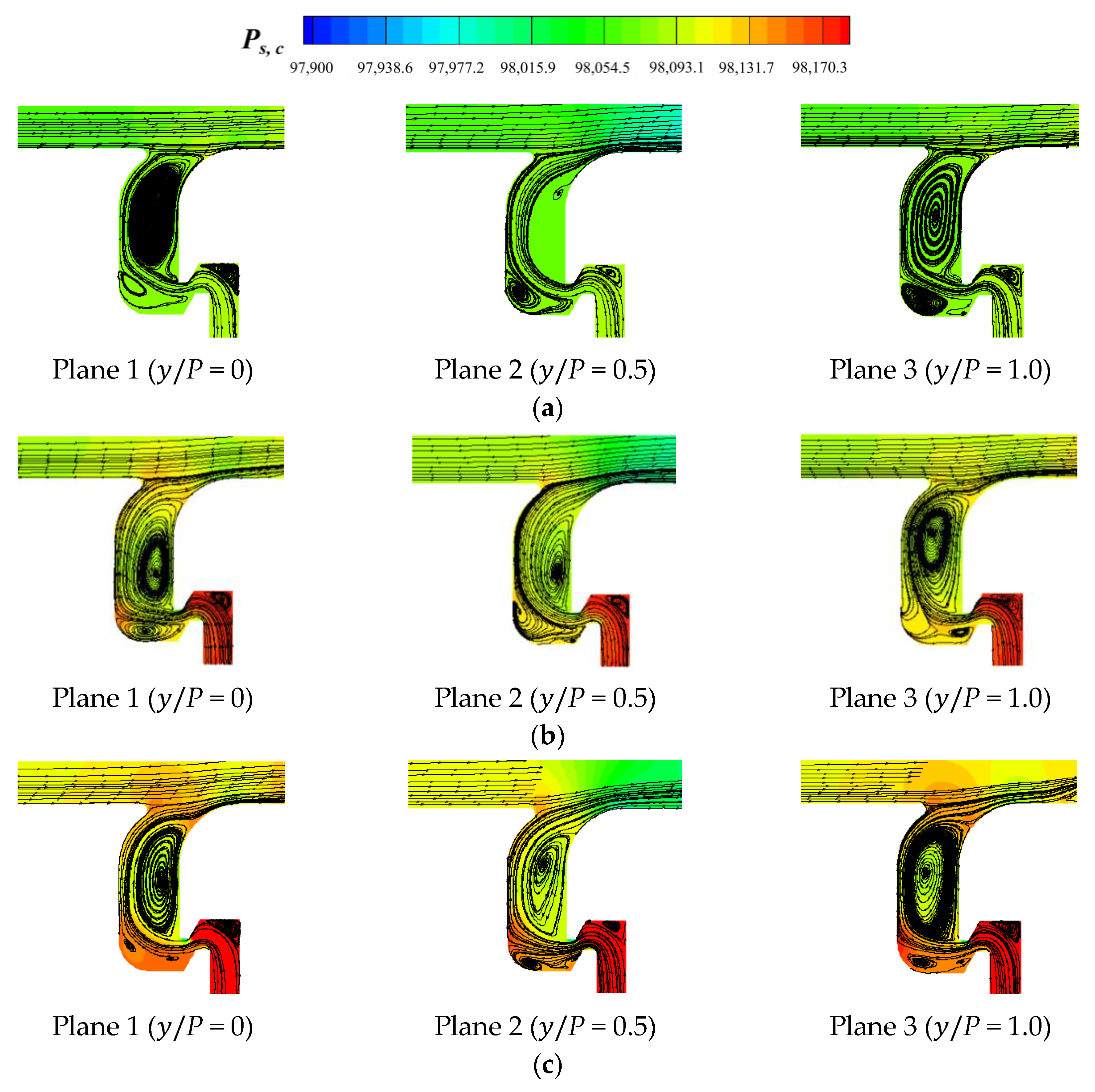
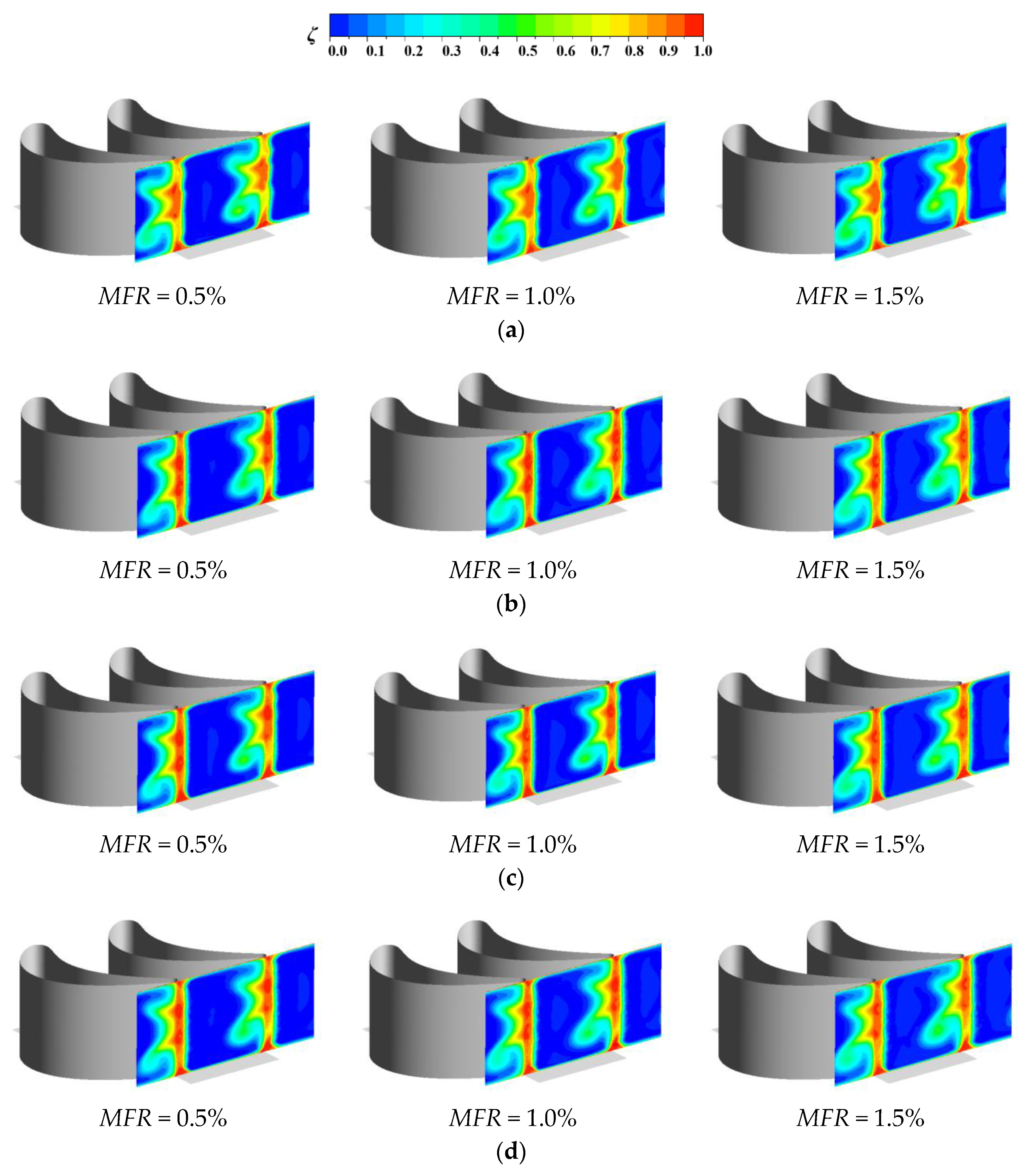

| Parameters | Value |
|---|---|
| Axial chord, Cax | 126.9 |
| H/Cax | 0.615 |
| P/Cax | 0.670 |
| Inlet geometric angle, βin/deg | 41.1 |
| Outlet geometric angle, βout/deg | 32.4 |
| Attack angle, γ/deg | 0 |
| Point | Mainstream | Coolant | LED Blue Light |
|---|---|---|---|
| 1 | On | On | On |
| 2 | On | Off | On |
| 3 | Off | Off | On |
| 4 | Off | Off | Off |
| Boundary Condition | Value |
|---|---|
| Mainstream inlet static temperature | 298.15 K |
| Mainstream inlet CO2 fraction | 0% |
| Coolant mass flow rate | 0.6375–1.9125 g/s |
| Coolant inlet static temperature | 288.15 K |
| Outlet static pressure | 97.5 kPa |
| Averaged mainstream velocity | 30 m/s |
| Mainstream turbulence intensity | 10% |
| Coolant turbulence intensity | 5% |
| Wall properties | Adiabatic, smooth |
Disclaimer/Publisher’s Note: The statements, opinions and data contained in all publications are solely those of the individual author(s) and contributor(s) and not of MDPI and/or the editor(s). MDPI and/or the editor(s) disclaim responsibility for any injury to people or property resulting from any ideas, methods, instructions or products referred to in the content. |
© 2023 by the authors. Licensee MDPI, Basel, Switzerland. This article is an open access article distributed under the terms and conditions of the Creative Commons Attribution (CC BY) license (https://creativecommons.org/licenses/by/4.0/).
Share and Cite
Lu, Y.; Liu, Z.; Zhang, W.; Ding, Y.; Feng, Z. Experimental and Numerical Investigations into the Effects of Rim Seal Structure on Endwall Film Cooling and Flow Field Characteristics. Energies 2023, 16, 7976. https://doi.org/10.3390/en16247976
Lu Y, Liu Z, Zhang W, Ding Y, Feng Z. Experimental and Numerical Investigations into the Effects of Rim Seal Structure on Endwall Film Cooling and Flow Field Characteristics. Energies. 2023; 16(24):7976. https://doi.org/10.3390/en16247976
Chicago/Turabian StyleLu, Yixuan, Zhao Liu, Weixin Zhang, Yuqiang Ding, and Zhenping Feng. 2023. "Experimental and Numerical Investigations into the Effects of Rim Seal Structure on Endwall Film Cooling and Flow Field Characteristics" Energies 16, no. 24: 7976. https://doi.org/10.3390/en16247976








